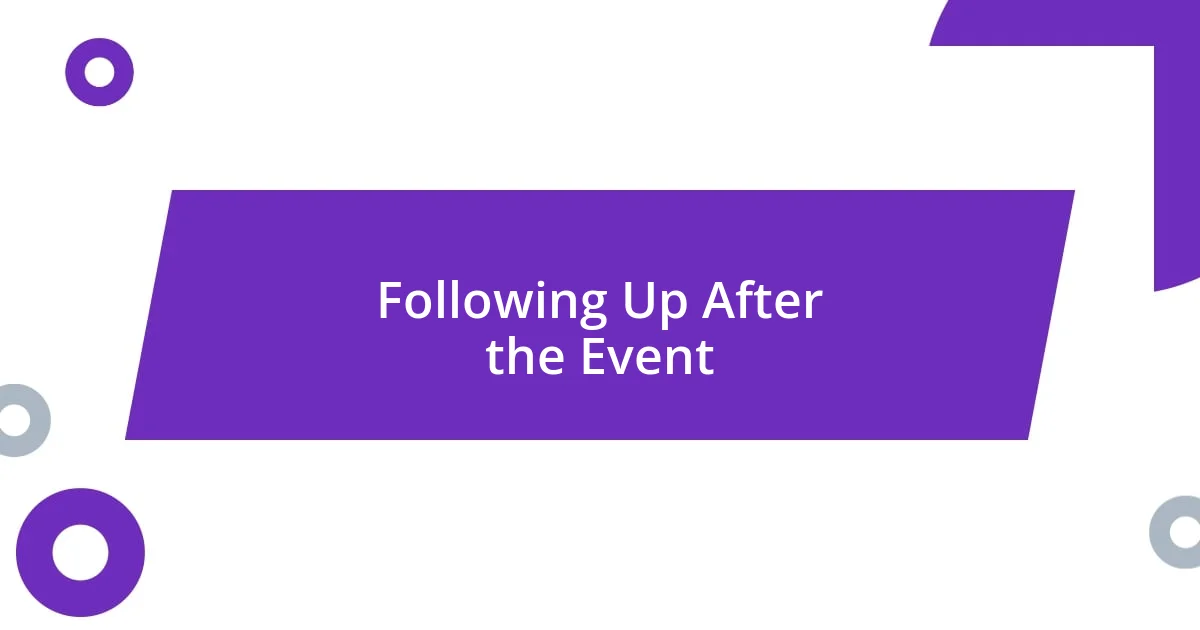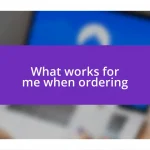Key takeaways:
- Invitations are vital in setting the tone for gatherings, enhancing guest excitement and fostering connections with thoughtful design and personalization.
- Creating a welcoming atmosphere involves attention to detail, such as lighting and decorations, which can significantly affect guests’ moods and comfort levels.
- Effective RSVP management includes clear deadlines, organized tracking, and follow-ups to ensure clarity and inclusion, while post-event follow-ups help strengthen relationships and gather valuable feedback.

Understanding the Importance of Invitations
Invitations set the tone for any gathering, shaping expectations and excitement for both the host and the guests. I remember the thrill I felt receiving a beautifully crafted invitation to a friend’s wedding; it made me feel special and valued, like my presence truly mattered. Can you think of a time when an invitation made you feel genuinely excited about attending an event?
When I send out invitations, I invest thought into the design and wording because it reflects my intentions. I’ve learned that a heartfelt message, whether formal or casual, communicates that I care about the experience my guests will have. Have you ever received an impersonal invite and felt a little undervalued? It reinforces the idea that a well-crafted invitation can significantly enhance the overall experience for everyone involved.
Moreover, invitations can ignite curiosity and anticipation, drawing friends and loved ones closer to each other. I often find that the unique details I include, like a fun dress code or a theme, spark conversations long before the event. Isn’t it amazing how something as simple as an invitation can foster connections and create a buzz?

Choosing the Right Invitation Style
When it comes to choosing the right invitation style, I believe the key is to align it with the event’s vibe. For my recent cozy dinner party, I opted for handmade invitations featuring a rustic design that perfectly captured the ambiance of our evening. Guests expressed their excitement over the unique touch, which made them feel valued and set the stage for an intimate gathering.
Here are a few styles to consider based on the event:
- Formal Invitations: Best for weddings or corporate events; they convey a sense of sophistication.
- Casual Invitations: Great for relaxed gatherings like BBQs or game nights, focusing on playful designs and lighthearted language.
- Themed Invitations: Perfect for themed parties, creating intrigue about the dress code or activities.
- Digital Invitations: Convenient for last-minute events; they often include animations or music for a fun twist.
- Handwritten Invitations: Add a personal touch, making your invite feel truly special and thoughtful.
Choosing the right style not only reflects your personality but also invites guests into the experience you’re creating. I’ve noticed that my friends always seem to appreciate the effort I put into the invitation’s design, which often leads to higher enthusiasm and a stronger turnout.

Crafting a Personalized Invitation Message
Crafting a personalized invitation message requires attention to the recipient’s preferences and personality. For instance, when inviting my best friend to a surprise birthday party, I included a playful inside joke that made her smile instantly. It’s these personal touches that create a warm connection and ignite excitement about the event. Have you ever felt that spark of joy when an invite resonates with you personally?
I find that addressing the guest by name in the invitation sets a welcoming tone right from the start. When I crafted an invitation for my sister’s engagement, I made sure to highlight her love story in a few sentences. I could almost feel her joy radiating from the words. This not only adds a sentimental touch but also reinforces the significance of the occasion we’re celebrating together.
Another practice I embrace is incorporating specific details that reflect shared experiences or interests. For example, when I invited my friends to a movie night featuring their favorite film, I referenced memorable moments we shared while watching it together. It’s fascinating how such details can build excitement and anticipation for the gathering. Why not consider what unique element you could mention that connects you to your guests and enriches their invitation experience?
| Element | Traditional Invitations | Personalized Invitations |
|---|---|---|
| Greeting | “Dear Guest,” | “Hey [Friend’s Name],” |
| Message Tone | Formal and General | Warm and Fitting to Relationship |
| Details Included | Basic Event Info | Shared Memories or Interests |
| Closing Line | “Sincerely,” | “Can’t wait to celebrate with you!” |

Creating a Welcoming Atmosphere
Creating a welcoming atmosphere starts long before guests arrive. I remember the first dinner party I hosted; I made sure to light some candles and play soft background music that reflected the evening’s mood. The glow and gentle tunes transformed the room into a quaint haven, instantly putting everyone at ease. Have you ever noticed how the right lighting can change a place entirely?
As the guests arrived, I decorated the entryway with fresh flowers and a warm welcome sign. It was a small touch, yet it planted a sense of excitement right from the doorstep. I could see their faces light up as they stepped inside, a clear indication that these details matter. What do you think happens to someone’s mood when they feel recognized the moment they walk in?
Once everyone was seated, I took the time to engage each person in conversation, making an effort to connect on a deeper level. I find that when you show genuine interest in your guests’ lives — asking about their recent travels or sharing laughs about old memories — it fosters a sense of belonging. After all, it’s the company we keep that often defines the warmth of our gatherings, isn’t it?

Managing RSVP Responses Effectively
Managing RSVP responses effectively can sometimes feel daunting, but I’ve discovered that following up is key. I remember hosting a summer barbecue and receiving mixed signals from my friends about attending. A friendly text message a few days later not only clarified who was coming but also sparked excitement in those who hadn’t yet decided. People often appreciate a little nudge to remind them of the fun they might miss out on.
Having a clear deadline for RSVPs is another strategy I swear by. When I planned a holiday gathering last year, I set a strong RSVP date about two weeks before the event. This gave me ample time to make arrangements without feeling rushed. Plus, it feels good to have a deadline; it encourages those who are on the fence to commit. Do you ever find that having a timeline can help you make decisions faster?
I also learned the importance of keeping track of responses in an organized way. Utilizing a simple spreadsheet helped me visualize who was attending and who hadn’t responded yet. I could easily send reminders to those who hadn’t replied, ensuring no one felt overlooked. It’s amazing how easy it is to feel disconnected when you’re left in the dark about an event—wouldn’t you agree that clarity makes everyone feel more included?

Following Up After the Event
After the event, I make it a priority to reach out to my guests. A few days after my last gathering, I sent personalized thank-you messages that reflected on the conversations we shared. It’s incredible how a simple note can evoke feelings of appreciation and connection, don’t you think? I find that this small gesture not only reinforces relationships but also encourages guests to reminisce about the good times, fostering a lasting bond.
I’ve also learned that asking for feedback can be invaluable. After one particularly chaotic dinner party, I candidly asked a couple of friends what they thought. Surprisingly, their insights helped me realize where I could improve, and yes, they even had ideas for future themes! I now approach this as an opportunity for growth; it’s fascinating how understanding other perspectives can shape future gatherings. Wouldn’t you agree that every experience is a lesson waiting to be uncovered?
Lastly, sharing photos from the event can reignite the joy of the occasion. I once created an album on social media after hosting a cozy brunch, and the responses were heartwarming. Friends commented with fond memories and even suggested we do it again soon. This back-and-forth not only keeps the excitement alive but also opens the door to planning the next get-together. Have you noticed how revisiting shared moments can enhance friendships?














